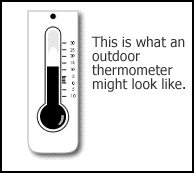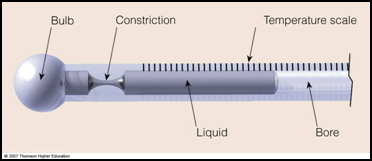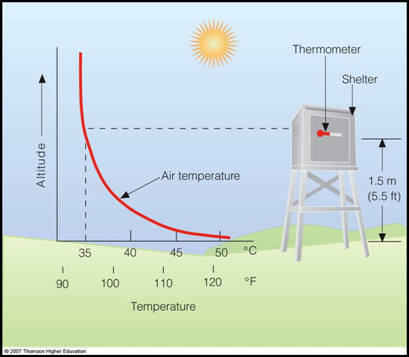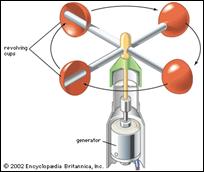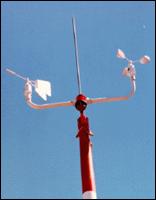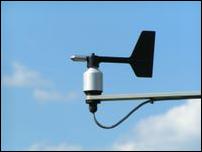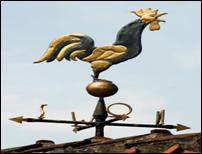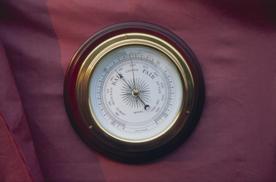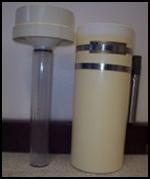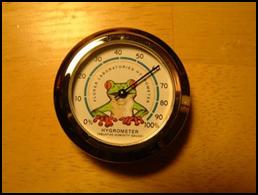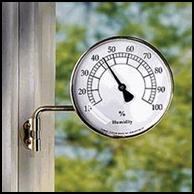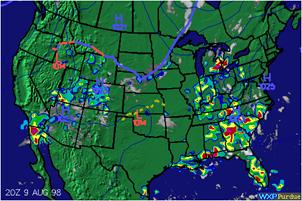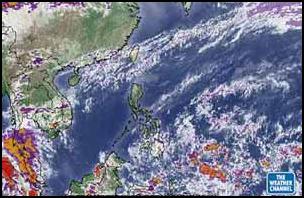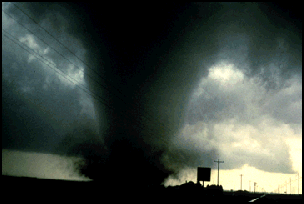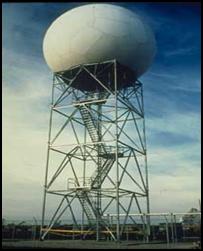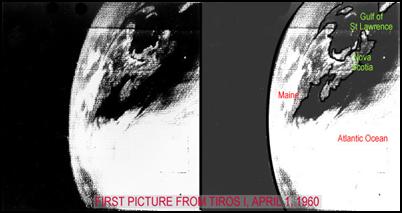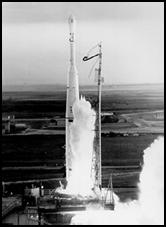![]()
![]()
![]()
![]()
DESCRIBING WEATHER
Unit
Overview
Have you ever
wondered why weather conditions are always changing? You can see clouds, wind,
rain, and snow that are signs that tell us about the weather. Remember in an earlier unit that weather is
the condition of the air around us? There are other things that can be used to
describe the weather. In this unit you
will learn about temperature, direction, and speed of wind, precipitation, and the barometric
pressure in the weather. You will see
how some of these qualities affect the weather the most. While you study this unit try to keep in mind
the four seasons here on Earth.
|
VOCABULARY |
|||
|
atmosphere |
seasons |
expands |
limit |
|
contracts |
reveals |
humidity |
|
|
absorb |
precipitation |
steady |
|
The ten vocabulary words above are used throughout unit
four. Be prepared to know what the words
mean so that you can understand how the words are used in the unit. Below are some definitions you can practice
to help you understand the words better.
|
|
DEFINITIONS |
|
atmosphere |
is the gases that surround
the earth and other planet |
|
absorbed |
means to soak up or take up
or use up |
|
reveals |
to make known or to allow
to be seen |
|
steady |
means to firmly fix,
support, or balanced |
|
expands |
to make or become larger or
more extensive |
|
controls |
means the power to influence
people or to influence the course of events |
|
seasons |
are each of the four
divisions of the year (spring, summer, autumn, and winter) and marked by
particular weather patterns and daylight hours |
|
limit |
is a point beyond which something
does not or may not pass |
|
humidity |
is an increased level of
moisture in the air |
|
precipitation |
is rain, snow, sleet, or
hail that falls to or condenses on the ground |
The first thing to consider about weather is air temperature. It is air temperature that affects the
weather more than anything else. It is
the sun that determines the air’s temperature.
What happens is the sun sends in energy to the atmosphere. This is where
the sun’s energy is absorbed and
then turns into heat. Cold air that
creates high-pressure areas reveals
mild or fair weather. Warm air that
creates low pressure does not weigh as much as cold air and it will reveal
cloudy or sometimes storming weather.
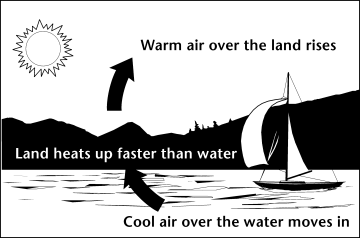
Now that we have discussed air temperature, think about the
way air moves. Moving air is called wind
and it has a path that it usually follows.
What happens is when there is high pressure in an area; air usually 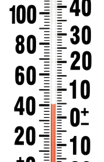 goes to an area of low pressure. Before you look at how these weather
qualities can be measured it would be a good time to review weather by using
some weather instruments. Air
temperature can be checked by a thermometer.
Your own body temperature can be checked with a thermometer. A thermometer that is used for checking
weather has numbers on it that use a scale.
When the mercury in the thermometer’s tube becomes hotter, it expands and rises up the tube. The opposite happens when the mercury
cools. As the mercury drops it contracts
goes to an area of low pressure. Before you look at how these weather
qualities can be measured it would be a good time to review weather by using
some weather instruments. Air
temperature can be checked by a thermometer.
Your own body temperature can be checked with a thermometer. A thermometer that is used for checking
weather has numbers on it that use a scale.
When the mercury in the thermometer’s tube becomes hotter, it expands and rises up the tube. The opposite happens when the mercury
cools. As the mercury drops it contracts
|
Liquid-in-glass thermometer: glass tube filled with liquid
(often mercury or alcohol) that expands/contracts
with air temperature |
|
|
|
Inside of a thermometer |
|
How a thermometer is used. |
|
|
|
|
|
One of the most common things about the weather that people measure is how hot or cold it is - the air temperature. (above) You can see how the thermometer is used to measure the air temperature. |
|
The direction of the wind can be found using wind vanes or
anemometers. Both of these tools can find
the wind direction by which way the wind is coming. Keep in mind that the
temperature of the air tells how hot or cold it is outside. As the weather (the condition of the air
around us) changes in temperature the wind also changes. Whether the wind is giving a calm day, or a
gentle breeze, or a strong wind such as a hurricane, the weather’s temperature
and the wind direction and speed help us to understand the seasons here on Earth.
Before looking at the seasons,
the precipitation and the barometric
pressure in weather needs to be better understood. The weather changes from season to season and
there are four seasons on
Earth. Summer, autumn, winter, and
spring are the four seasons. The season of summer will be a good place to
start. In the summer the air temperature
gets warm and in autumn air temperature gets cooler. In the winter the air temperature gets colder
and in spring air temperature turns warmer.
It is the air’s pressure that pushes against its surroundings that can
explain what barometric pressure is all about when studying weather.
|
ANEMOMETER |
|
|
The revolving-cup electric
anemometer is used to measure wind speeds. The revolving cups drive an
electric generator that operates an electric meter. |
|
|
Anemometer
and direction vane mounted atop an instrument tower. |
|
|
WHAT IS A WEATHER VANE? |
||
|
|
A weather vane, also called
a wind vane, is a movable device attached to an elevated object such as a
roof for showing the direction of the wind. |
|
Air pressure can be measured with a barometer. Air pressure changes with the
temperature. Warm air will result from
this in the air and the air particles move farther apart. As air particles move away from each other,
low air pressure results. With cold air
the opposite is true. When cold air
presents itself, the air particles move closer together. It is good to know that the differences in
air pressure in an area that causes the wind to change.
|
ANEROID
BAROMETER |
|
|
Aneroid barometer is an instrument
for measuring the atmospheric pressure. It registers the change in the shape
of an evacuated metal cell to measure variations on the atmospheric pressure. |
|
Which direction the wind blows is why a wind or weather vane
is used. It is the anemometer that
determines the wind (air) speed. As water
vapors change in the air three things are affected and they are humidity, clouds, and precipitation. Humidity and clouds will be looked at more closely in a future
unit. It is precipitation that is important to check at this time. You learned in the last unit about
evaporation and condensation. Now a
glance at humidity! A rain gauge is 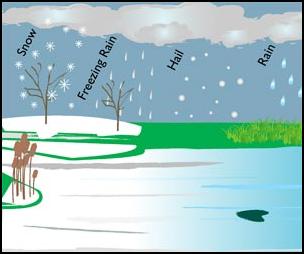 what is used to measure precipitation. Weather people measure precipitation at the same time every day. Precipitation
is not just rain, it is snowfall too.
However, snow would need to melt before it could be measured
accurately. Keep in mind that the amount
of water vapor in the air is humidity.
When water vapors change so does the weather. Try to recall what was said earlier in this
unit about temperature. There is a limit to the amount of water (precipitation) that the air can
hold. Because this limit is not steady or
constant, it is the temperature of the air that causes the amount of water to
change. Think about what the weatherman
says on television when he/she talks about the relative humidity during a weather forecast.
Two things are important to know when is comes to relative humidity. They are how much water vapor is in the air
and the temperature it is outside at the time of the measurement. These are compared to the total amount that
could be held at that given temperature.
Sounds like a lot of information, doesn’t it? Think of it this way. If the weather person says the relative humidity is 80%, then the air is
holding 20% less water than what it usually does. So, the role of water vapor in the air causes
different types of precipitation,
cloud formation, and humidity.
what is used to measure precipitation. Weather people measure precipitation at the same time every day. Precipitation
is not just rain, it is snowfall too.
However, snow would need to melt before it could be measured
accurately. Keep in mind that the amount
of water vapor in the air is humidity.
When water vapors change so does the weather. Try to recall what was said earlier in this
unit about temperature. There is a limit to the amount of water (precipitation) that the air can
hold. Because this limit is not steady or
constant, it is the temperature of the air that causes the amount of water to
change. Think about what the weatherman
says on television when he/she talks about the relative humidity during a weather forecast.
Two things are important to know when is comes to relative humidity. They are how much water vapor is in the air
and the temperature it is outside at the time of the measurement. These are compared to the total amount that
could be held at that given temperature.
Sounds like a lot of information, doesn’t it? Think of it this way. If the weather person says the relative humidity is 80%, then the air is
holding 20% less water than what it usually does. So, the role of water vapor in the air causes
different types of precipitation,
cloud formation, and humidity.
|
WHAT IS A RAIN GAUGE? |
|
|
A rain gauge is a type of instrument
used by meteorologists and hydrologists to gather and measure the amount of
liquid or solid (snow, sleet, and hail) precipitation
over a set period of time. |
|
Over the course of the hot summer we have all experienced a
humid day. A device called a hygrometer informs us on the humidity level each day.
|
WHAT IS A
HYGROMETER? |
|
|
|
|
|
This is a picture of an
indoor hygrometer. |
This is a picture of an
outdoor hygrometer. You can read outdoor humidity
from indoors. |
What
is Humidity?
Humidity is the amount of moisture
in the air. It can be measured in various ways, but the most usual is to
describe it as 'relative' humidity. This
is expressed as a percentage. A relative humidity
of 100% means the moisture content of the air is the maximum possible at any
particular temperature. The hotter the air, the more moisture it can hold.
Why
is it Important?
When relative humidity is low,
evaporation is rapid. Soil dries out, wet clothes dry quickly and perspiration
evaporates from the skin. When relative humidity
is high, clothes dry slowly and body sweat cannot evaporate easily. We feel
sticky and hot and because our perspiration cannot evaporate quickly, we feel
uncomfortable. We can stand dry heat much better than damp heat which makes us
feel listless and takes our energy away.
Supercomputers
|
NOAA
ACTIVATES NEWEST CLIMATE AND WEATHER SUPERCOMPUTERS |
|
|
|
The National Oceanic and
Atmospheric Administration’s newest weather and climate supercomputers,
increasing the computational might used for the nation's climate and weather
forecasts by 320 percent. The new IBM machines process 14 trillion
calculations per second at maximum performance and ingest more than 240
million global observations daily. Photo credit “NOAA.” |
Weather Maps
|
WEATHER MAPS |
|
|
|
Weather maps are maps that
show predictions of coming weather or report on weather that is actually
happening. Weather is how hot or cold or how wet or dry it is in a location
over a short period of time. |
Radar
|
RADAR |
|
|
“Is it going to rain or
should I pack the sunscreen?” One of the first things many of us do before
leaving the house each morning is check the weather forecast. Although we
often complain about the accuracy (or seeming lack thereof) of the
weatherman’s predictions, the truth is that weather forecasts are usually
very reliable, at least in the short term. This is due, in large part, to the
use of weather radar. The idea that radar could
be used to detect precipitation
(rain, snow, etc.) was first suggested in 1941. A year later, testing of
early radar systems showed that rain did show up on radar screens. In fact,
when the weather showed up on these early radar screens it created big
problems. Engineers found that storms appeared as large areas of moving
“clutter” on their screens and obscured the targets (such as ships or
airplanes) that they were seeking. The military were quick to exploit the
discovery that radar could be used to detect weather. The military trained
dozens of meteorologists in radar technology and by 1943 surface-based and
airborne weather radar observations were being established worldwide by the |
|
|
|
(left) A typical weather
radar image, similar to one we might see on the local news. This one is of
weather over and around Courtesy: The Weather
Channel |
|
(right) Weather radar can give us advance warning of potentially dangerous weather, such as tornadoes. Courtesy: National Severe Storms Laboratory. |
|
|
One of the radars in the NEXRAD network. Courtesy:
National Oceanic and Atmospheric Administration. |
|
|
In the |
|
Weather Satellites
|
TIROS I THE FIRST METEOROLOGICAL SATELLITE |
|
|
During the
1950s weather scientists gave serious thought to capturing images of
meteorological phenomena from satellites launched into space by powerful
rockets. Dr. Harry Wexler, chief scientist of the Weather Bureau during that
period, strongly advocated meteorological satellites. In March 1958, the
President's Science Advisory Committee stated "The satellite that will
turn its attention downward holds great promise for meteorology and the
eventual improvement of weather forecasting." Two months later, Project
TIROS (Television and Infra-Red Observation Satellite) was born when the U.S.
Committee on Meteorological Satellites began its initial planning sessions. |
|
|
The first image taken from TIROS I on
April 1, 1960. When stations on Earth received data from TIROS, technicians
recorded it on 35 millimeter film for making prints and large projections of
the image. Forecasters dreams of watching weather from space had finally come
true. |
|
|
TIROS I, the world's first
meteorological satellite blasts off aboard a Thor-Able rocket on April 1,
1960, from |
|
A barometer, wind vane, anemometer, rain gauge, supercomputers,
weather maps, weather satellites, hygrometer and radar are all instruments used
to measure the parts of the weather. Learning about the seasons and how they change will be easier when you understand the
parts that make up the weather.
Activity
One:
On a sunny day, take
a clear, plastic drinking cup and turn it upside and place it outside on the
grass in a safe place. Watch what
happens! Water molecules from the grass
and soil will evaporate and form water vapor in the glass.
Activity
Two:
Take a piece of paper and get it wet. Hold the wet paper and blow on it or take it
outside and let the wind blow on it.
What do you think will happen?
The paper will dry more quickly than a wet paper that has been placed in
an area where the air is still and quiet.
Wind will speed up evaporation.
Also, using a fan in this activity will show quick results.
The following list of information is
being given to you if you want to learn more about the 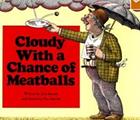 weather. A funny book to read about weather is called Cloudy
with a Chance of Meatballs by Judi Barrett.
weather. A funny book to read about weather is called Cloudy
with a Chance of Meatballs by Judi Barrett.

Below are additional educational resources and activities for this unit.
